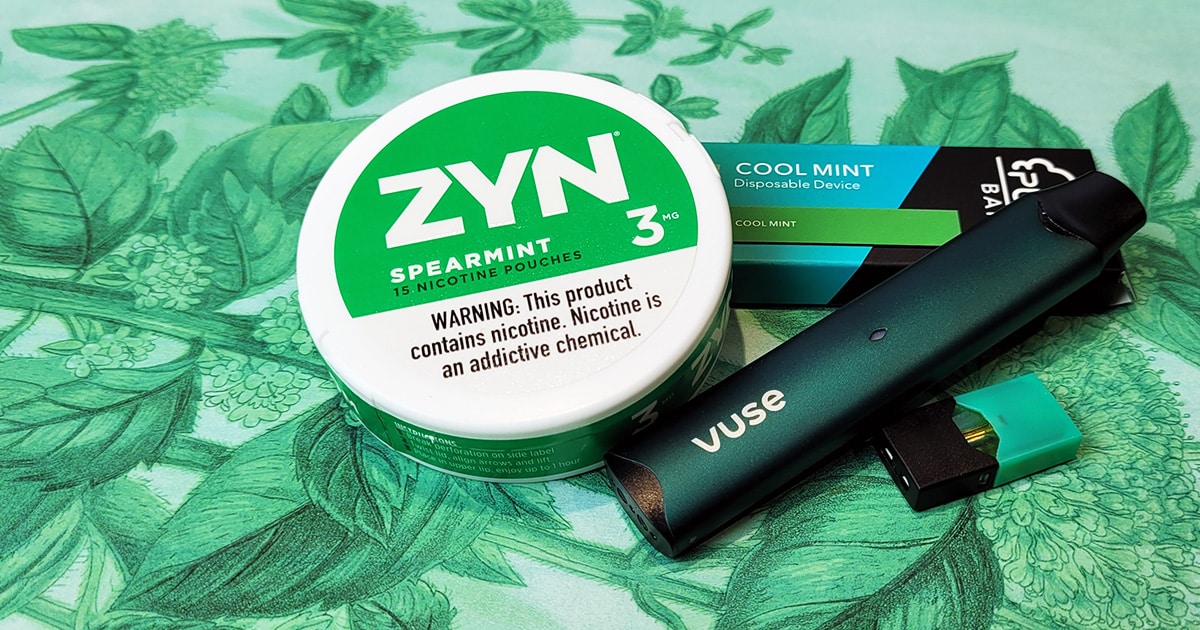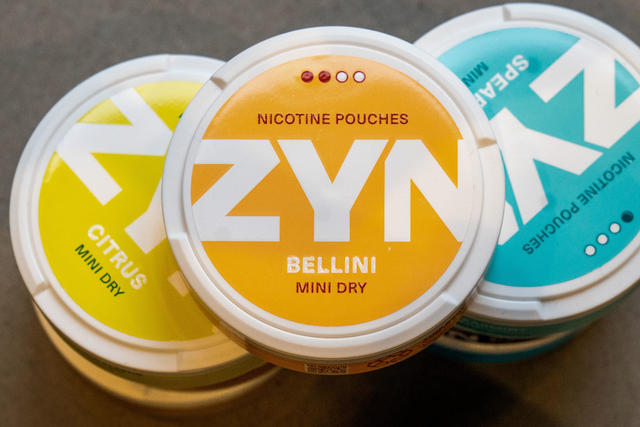Health
Zyn Nicotine Pouches Are All Over TikTok, Sparking Debate Among Politicians And Health Experts

Washington — The latest tobacco product selling online, Zyn, is a little pouch containing nicotine and flavours.
However, it has sparked a controversy among lawmakers, parents, and pundits, reflecting an increasingly complex picture in which Big Tobacco actively promotes alternative products while specialists grapple with their possible benefits and risks.
Zyn is available in mint, coffee, and citrus flavours and is marketed to adult tobacco users by Philip Morris International. However, videos of young people popping the pouches have received millions of views on TikTok and other social media platforms.
Zyn Nicotine Pouches Are All Over TikTok, Sparking Debate Among Politicians And Health Experts
Advocates are concerned that Zyn may become the newest nicotine product to entice underage kids, similar to how Juul sparked a years-long surge in vaping activity. Other scientists contend that the possibility of preventing people from using cigarettes and other traditional tobacco products, which result in 480,000 deaths each year in the United States, balances the risk.
“The definition of insanity is doing the same thing and expecting a different result,” explained Dr. Jasjit Ahluwalia, an addiction specialist at Brown University. “That is how we’ve dealt with tobacco for decades. We’ve been all about abstinence, rather than promoting products that can prevent harm.”
Ahluwalia sees nicotine pouches and e-cigarettes as a means to assist smokers in reducing or quitting smoking.
That strategy is common in the United Kingdom, but it is not part of the medical mainstream in the United States, where only pharmaceutical-grade drugs such as nicotine gum and lozenges are officially allowed to assist smokers in quitting.
According to Ahluwalia, Zyn works like those products do: it releases modest quantities of nicotine, which are absorbed into the gums and reduce cravings. He emphasizes that the main distinction is that Philip Morris, the largest cigarette manufacturer in the world and a longtime foe of anti-smoking organizations, offers Zyn.
The Zyn debate has now spilt over into politics, pitting Democrats and Republicans in Washington against one another and sparking yet another conflict in the country’s culture war.
In late January, Democratic Senator Charles Schumer of New York urged regulators to look into Zyn, stressing its attraction to teenagers. Several House Republicans then warned residents that “Big Brother” planned to “ban nicotine.”
Tucker Carlson, a Zyn user, joined the fray, stating, “Zyn is not a sin,” praising its unverified benefits, such as “enhancing male vitality and mental acuity.”
Zyn users immediately evolved their online lexicon, which includes terms like “zynnies,” “zynner,” and “zynsky.”
Ollie Ganz, a tobacco and nicotine researcher at Rutgers University, said that there is a young male-led online subculture around Zyn, but much of that is not coming from the brand itself.
Online videos show young people chronicling their first Zyn experiences, comparing different taste combinations, and showcasing heaping stacks of used canisters.
“It’s concerning to see the countless Zyn-related memes and hashtags that are being amplified and normalized across social media,” said Kathy Crosby, CEO of the Truth Initiative, an anti-tobacco advocacy group.
Truth and other groups cite data indicating that nicotine can interfere with adolescent brain development.
The Food and Drug Administration’s responsible for balancing Zyn’s hazards to children with its potential to benefit adults.
According to an FDA representative, the government is monitoring underage use, with 1.5% of high school and middle school students reporting using pouches last year. That is well below the 10% who use e-cigarettes.
Zyn Nicotine Pouches Are All Over TikTok, Sparking Debate Among Politicians And Health Experts
The FDA has allowed Zyn to remain on the market while they assess Philip Morris’ marketing application, which has been waiting since 2020. If teen use continues low, the company may be able to obtain FDA approval for at least part of its products, which are available in several strengths and a dozen flavours.
In 2019, the FDA granted its first reduced-risk classification to a similar product: snus, a tobacco pouch popular in Sweden that has fewer carcinogens than cigarettes. The FDA stated that smokers who switch to snus lessen their risk of lung cancer, bronchitis, and other ailments.
Zyn eliminates the tobacco leaves contained in snus, leaving only nicotine, which Philip Morris claims boosts its attractiveness.
“People may be hesitant to switch to an oral tobacco product if they believe it is similar to traditional chewing tobacco,” business spokesman Corey Henry explained. “Consumer acceptability is a big part of Zyn.”
Henry says Philip Morris does not market Zyn through internet influencers or endorsements. The website is only available to people over the age of 21. Flavours such as cinnamon and peppermint are “familiar to adults,” Henry added.
Zyn launched in the United States in 2014, but sales have skyrocketed in the last year, producing $1.8 billion as shipments increased by more than 60% yearly.
On a November call with retailers, a firm executive described the rise as “gonzo” and “lights out.”
“I did not see this coming. “I don’t know anyone who did,” said Joseph Teller, the head of oral tobacco products.
Zyn Nicotine Pouches Are All Over TikTok, Sparking Debate Among Politicians And Health Experts
Zyn’s advertisements emphasize the pouches’ unobtrusive and convenient nature as a “smoke-free,” “spit-free” alternative for smokers “at work” or “on the move.”
However, to achieve the company’s claimed objective of a “smoke-free future,” Zyn will need to assist customers in completely quitting cigarettes rather than cycling between them.
There is limited research on switching, and preliminary findings show there may be better solutions than pouches.
Researchers at Ohio State University recently discovered that it took smokers 30 minutes to an hour to receive enough nicotine from Zyn to satisfy their cravings. Cigarette smokers achieved the same nicotine levels—and relief—in five minutes.
“The pouches we studied, especially those with lower nicotine concentrations, did not appear to meet the needs of smokers,” stated study leader Brittney Keller-Hamilton. “That being said, they didn’t totally flop either.”
For the time being, smokers who have found success with Zyn are hoping it remains available.
Last spring, while working as a bartender in Portland, Oregon, Justin Wafer, 39, was smoking one pack every day. On hectic days, he would vape instead of taking a smoke break.
But, when his reloadable electronic cigarette failed in May, he tried Zyn. He now pops a pouch every three to four hours and claims to have not smoked in over nine months.
“I don’t see how it’s any different from pharmaceutical solutions like lozenges or gum,” he said. “Except it’s easier to get and tastes better.”
SOURCE – (AP)
Health
Kelly Clarkson Weight Loss Wasn’t Ozempic It Was a High Protein Diet

Kelly Clarkson’s remarkable weight loss has been a major topic of conversation for quite some time now, and the 42-year-old singer and talk show presenter has been very open about it with her fans!
The Kelly Clarkson program host had spoken up about her ever-shrinking figure multiple times, including on her talk program, when she admitted to utilizing a weight loss injection (not Ozempic!) to help her owing to being pre-diabetic.
Kelly revealed that she has lost a lot of weight, saying, ‘Mine is a different one than people assume, but I ended up needing to do it also because my blood work was so poor.’ She said that she had not taken Ozempic.
Kelly Clarkson did not name the medicine but described it as “something that aids in the breakdown of the sugar—my body does not do it right.”
She said her doctor ‘chased [her] for, like, two years’ to take the medication, but she was concerned about the consequences on her thyroid. However, she took it after seeing a birthday special she intended to release.
Kelly Clarkson Weight Loss
‘All of a sudden I halted it, and I was like, “Who the f*ck is that?'” she added. “You see it and you’re like, “Well, she’s about to die of a heart attack”,” Kelly said.
Whoopi, for her part, said she shed the weight of ‘nearly two people’ after ‘taking that great shot that works for persons who need some help.’
“It’s great for people like us who have issues,” the View co-host continued. She mentioned earlier that she is using Mounjaro for weight loss.
Her weight loss began following a health concern.
Kelly Clarkson originally hinted at her weight loss on her talk show, The Kelly Clarkson Show, in December 2023. According to US Today, she previously stated that she no longer wore Spanx. “It’s quite cold inside this building. I don’t even have to wear Spanx anymore. “I just wear them for warmth, like thermals,” Kelly explained during a singing game.
However, on January 29, Kelly said on her show that she was doing ‘ something’ about her weight after obtaining a pre-diabetic diagnosis a few years prior.
(According to the Centres for Disease Control and Prevention, pre-diabetes means having blood sugar levels that are ‘greater than usual’ but not high enough for a type 2 diabetes diagnosis.) ‘I wasn’t astonished,’ she explained. ‘I was a little bit overweight.
‘They said, “You’re pre-diabetic.” You’re right on the brink.” And I was like, “But I’m not there yet,” she added. ‘And then I waited two years and said, “Okay, I’ll do something about it.”‘
High Protein Diet
Kelly Clarkson has changed her diet and is focussing on consuming plenty of protein.
‘I eat a healthy mix,’ she told People. ‘I lost weight because I listened to my doctor, which I hadn’t done in a few years. And I succeed 90% of the time since a protein-rich diet already benefits me. I’m a Texas gal, so I enjoy meat—sorry, vegans of the world!”
Kelly stated that her diet is a ‘healthy mix’, which means she still allows sweets.
I still indulge. ‘The other night, I had frozen yoghurt with my daughter, and it was fantastic,’ she continued.
Kelly stated that in 2018 when on a weight-loss journey, she would change the ingredients in her meals to make them healthier. ‘It’s the same stuff you eat; I use different ingredients,’ she explained.
‘Even for fried chicken, I use cassava flour, tapioca, or almond flour, while you use hormone-free chicken.’
However, Kelly agreed that this is not the most convenient option for most people. ‘I’m going to be honest with you: it’s incredibly expensive,’ she said.
Kelly later stated that she had lost weight after reading Dr. Steven Gundry’s The Plant Paradox. The Plant Paradox Diet is lectin-free, excluding beans, legumes, whole grains, some vegetables, and dairy.
‘I literally read this book, and I followed it for an autoimmune condition and a thyroid issue, and now all of my numbers are back up,’ Kelly told Extra the same year. ‘Thanks to this book, I’m no longer taking medication. It’s all about how we cook our food: non-GMO, pesticide-free, and eating organically.
In addition to nutrition and exercise, Kelly revealed that she has been using infrared saunas, which have been shown to promote sleep, ease tension and pain, and help clarify skin.
She’s also tried cold plunges. ‘I just took a chilly plunge because everyone wore me down,’ Kelly explained.
Related News:
7 Causes of Eye Bags: Why You Look Tired
Health
MAID Now Accounts for 1 in 20 Deaths in Canada

Medical assistance in dying (MAID), often known as voluntary euthanasia, accounted for 4.7% of Canadian deaths in 2023, according to new Health Canada data.
According to Heath Canada’s fifth annual report, since the Trudeau government legalized MAID in 2016, about 15,300 persons will undergo assisted death in 2023 if their applications are granted.
The median age in this group was more than 77. The great majority, almost 96%, died from “reasonably foreseeable” causes, such as cancer.
In a tiny number of other cases, patients may not have been terminally sick but wanted assisted suicide owing to a protracted and difficult illness that had significantly reduced their quality of life.
Canada is one of a few countries that have passed assisted dying legislation in the last decade. Others include Australia, New Zealand, Spain, and Austria.
In Canada, consenting adults can request medical help in dying from a healthcare physician if they have a serious and irreversible medical condition. Some constraints exist, such as requiring two independent healthcare providers to certify the patient’s eligibility before the request is authorized.
Quebec Highest in MAID Deaths
In 2023, more than 320,000 individuals died in Canada, with medical assistance accounting for 15,300 of those fatalities (or around one in every 20).
According to estimates presented by Health Canada on Wednesday, the rate of assisted dying in Canada would rise by about 16% in 2023. This figure represents a significant decrease from the average increase of 31% in prior years.
The research stated that it is too early to determine what caused the rate to slow. For the first time, the report examined race and ethnic data on persons who received MAID.
Around 96% of receivers identified as caucasian, who comprise over 70% of Canada’s population. It’s unknown what produced the difference.
The second-highest reported ethnic group was East Asians (1.8%), who comprise approximately 5.7% of Canadians.
MAID remained the most commonly used method in Quebec, accounting for roughly 37% of all euthanasia fatalities despite the province’s population being only 22% of Canada.
The Quebec government initiated a study earlier this year to investigate why its euthanasia rate was so high.
Expanded Access to MAID
In 2021, the Trudeau government expanded access to MAID for persons who do not have a terminal diagnosis but wish to terminate their lives due to a chronic, disabling ailment. Earlier this year, it was announced that access to those with mental problems would be expanded again.
However, it was postponed for the second time because Canadian provinces, which control healthcare delivery, raised concerns about the system’s ability to handle such a large expansion.
On Wednesday, Health Canada defended the procedure, citing the criminal code’s “strict eligibility” conditions.
However, Cardus, a Christian research tank, claimed the latest MAID data were “alarming” and revealed that Canada has one of the world’s fastest-growing euthanasia regimes.
A report released in October by the Ontario government offered some insight on contentious cases in which people were awarded assisted dying when they were not reaching the end of their natural lives.
One example was a woman in her fifties with a history of melancholy and suicide ideation who was extremely sensitive to chemicals.
Her plea for euthanasia was granted after she was unable to find a home that could meet her medical requirements.
Another example made headlines recently, involving a Nova Scotia cancer patient who claimed she was twice asked if she was aware of assisted dying as an option while undergoing mastectomy surgery.
According to the National Post, the question “came up in completely inappropriate places”.
Many other Canadian news sites have also covered incidents in which people with disabilities considered assisted suicide owing to a lack of housing or disability assistance.
Related News:
BC Supreme Court Stops MAID Death of Woman from Alberta
Health
Diabetes Patients May Benefit From GLP-1 Medications

(VOR News) – Individuals with diabetes utilising GLP-1 medications, such as Ozempic or Mounjaro, may be gaining an additional benefit, as suggested by recent research findings. This advantage is a diminished probability of developing a potentially fatal blood clot.
The study’s findings revealed that diabetic patients on specific medications exhibited a twenty percent reduced risk of developing venous thromboembolism (VTE) compared to those on alternative diabetic treatments.
Dr. Rushad Patell, the principal author of the study, remarked that “from a public health perspective, considering the widespread use of these [GLP-1] drugs, there exists potential to ascertain whether the overall incidence of VTE could be diminished at a national or population level as a consequence of this study.”
This pertains to the prevalence of diabetes medications.
Given the escalating risk of venous thromboembolism (VTE), it is plausible that this will result in a shift of the curve in the contrary direction.
At the American Society of Haematology’s (ASH) annual meeting, which took place in San Diego on Sunday, his team gave a presentation of their research findings. The meeting took place in San Diego.
It is essential to keep these data in a preliminary form until they are published in a peer-reviewed publication because they were presented at a diabetes medical congress. At the convention, the results were presented.
The researchers highlighted that vein thromboembolism (VTE) is a prevalent clot formation in veins that can pose significant risks. The two predominant forms of venous thromboembolism are pulmonary embolism and deep vein thrombosis (DVT). Pulmonary embolisms are defined by the migration of blood clots to the lungs, whereas deep vein thromboses (DVTs) are defined by the formation of blood clots in the legs.
Any form of venous thromboembolism (VTE) can lead to hospitalisation and potentially death if left untreated.
Could the newly discovered GLP-1 diabetic medications, which have achieved significant market success, aid in the prevention of venous thromboembolism?
Over 558,000 individuals in the United States were registered in a comprehensive health care database, and Patell’s team monitored the outcomes of these participants to gather information regarding the circumstances.
Patients were categorised into two groups, each including roughly 279,000 individuals: those utilising a GLP-1 drug for diabetes control and those receiving an older class of diabetes medication referred to as DPP4i. Patients with comparable health conditions were divided into these two groups. DPP4 inhibitors, conversely, do not induce weight loss in the manner that specific GLP-1 medications do.
In comparison to the cohort receiving alternative diabetes treatment, the group administered GLP-1 therapy exhibited an average incidence of venous thromboembolism (VTE) of 6.5 per 1,000 patients after one year.
Clots per 1,000 patients in the alternative diabetes cohort were 7.9.
According to Patell and his colleagues, the risk of blood clot formation was diminished by twenty percent as a result of this. The occurrence of pulmonary embolisms and deep vein thromboses (DVTs) has been shown to be decreasing.
The researchers found that the patient’s obesity status before taking GLP-1 did not affect the advantages regarding clotting risk, which were consistent regardless of the individual’s weight. The ambiguity remains over whether the decreased clotting risk associated with GLP-1s is due to weight loss in individuals or if an alternative mechanism is involved. There is insufficient comprehension concerning this issue.
“Further studies are necessary to ascertain the potential mechanism, whether via weight loss or alternative methods,” Patell stated in a news release disseminated at an ASH convention: “We must identify the potential mechanism through weight loss.”
The study could not establish that the use of GLP-1s was the cause of the reduction in clotting due to its retrospective design. The study was conducted, which was the reason for this situation. Consequently, Patell and his associates have asserted that a prospective clinical trial is essential to validate the evidence reported to date. Patell asserts that the newly acquired data may still offer direction to individuals with diabetes and the medical experts who manage their care.
His hypothesis is that this finding implies potential advantages in choosing a GLP-1 receptor agonist as an antidiabetic drug for patients. He stated, “It is crucial to consider thrombotic risk when selecting an antidiabetic agent for a patient.”
SOURCE: USN
SEE ALSO:
Vesta Care Dubai: Transforming Healthcare with Personalized Home Services
Bird Flu Testing Mandatory For Milk Supply In Exclusive-US Issued Order
-
Politics4 weeks ago
Miller Expects 4.9 Million Foreigners to Leave Canada Voluntarily
-
News3 weeks ago
Nolinor Boeing 737 Crash Lands in Montreal
-
News2 weeks ago
“Shocking Video” Vancouver Police Shoot Armed Suspect 10 Times
-
Tech4 weeks ago
Increasing its Stake in OpenAI by $1.5 Billion is a Possibility for SoftBank.
-
News4 weeks ago
Facebook Securities Fraud Case Dropped
-
Health4 weeks ago
A Canadian Teenager’s Bird Flu Virus Has Mutations


























